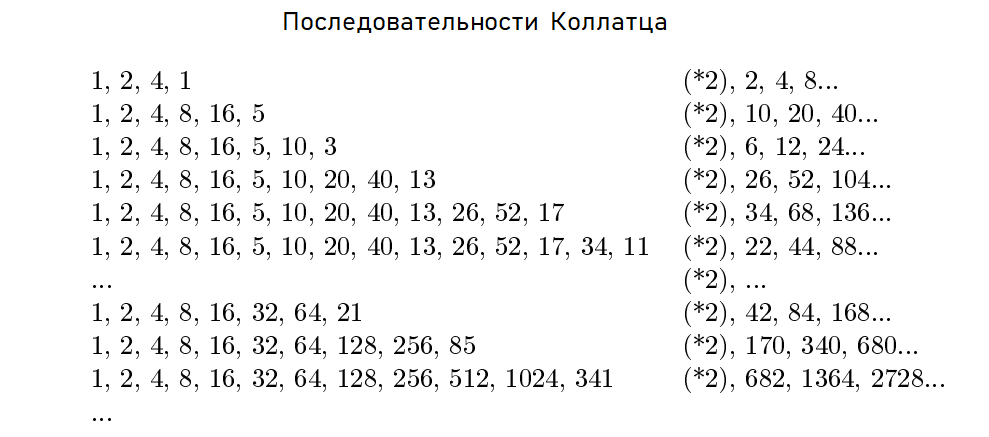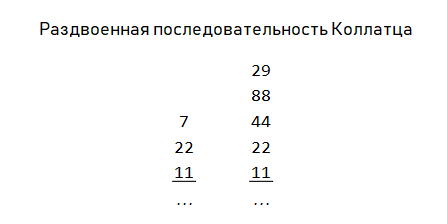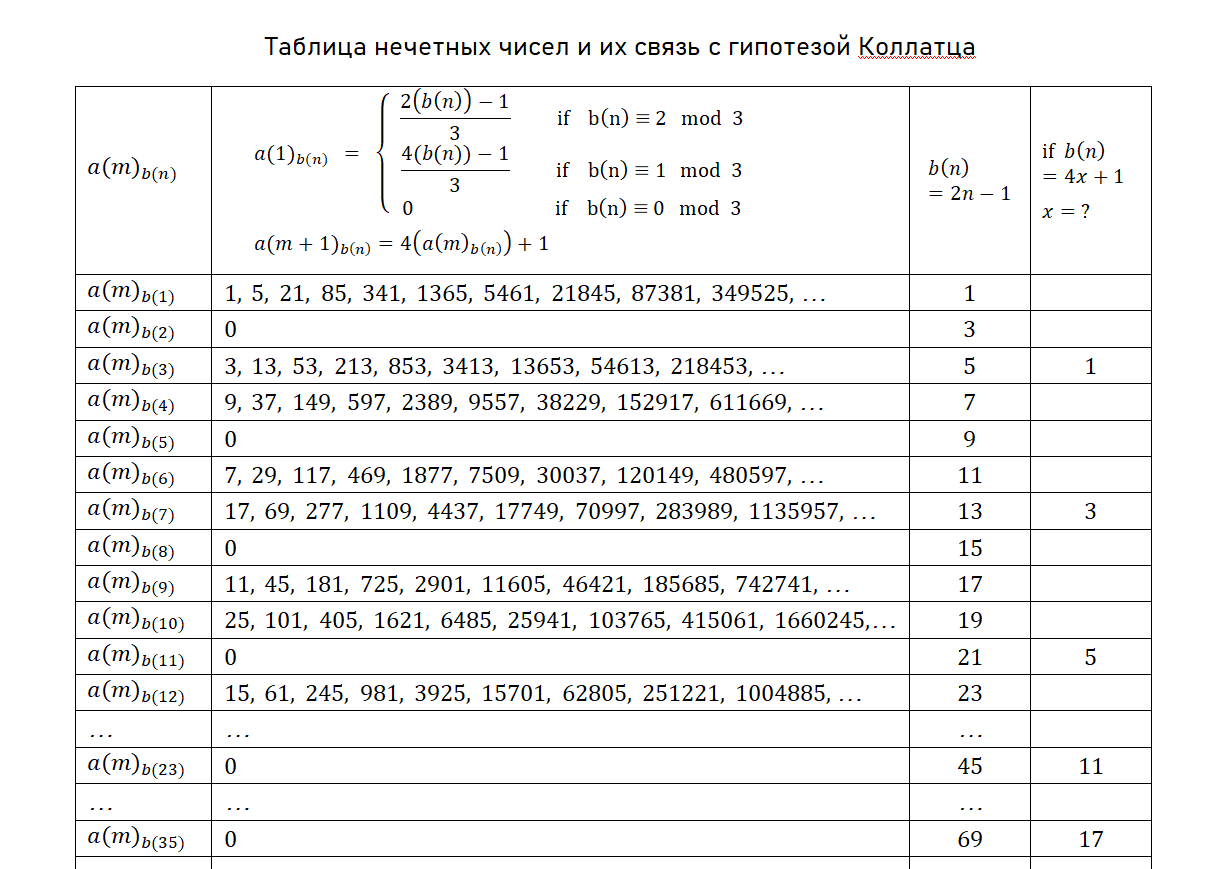Collatz Conjecture Part 1
annotation
This is the first article in the “Proof of the Collatz Conjecture” series, and to date the only article (in the world) that reveals the true nature of the Collatz Conjecture.
In this article, the author analyzes in detail the algorithm of the Collatz hypothesis, its structure, properties and features.
Keywords: Collatz conjecture, algorithm, recursion, recursion step, recursive descent, recursive ascent.
§ 1. Statement of the question
The Collatz conjecture is one of the unsolved problems in mathematics. Received wide popularity thanks to simplicity of a formulation.
Take any natural number ; If it is even, divide it by 2, and if it is odd, then multiply by 3 and add 1 (we get 3n+1); We perform the same operations on the resulting number, and so on.
What would be the starting number we don’t take, sooner or later we will get a unit, the hypothesis says. And you have to prove it.
§2. Introduction
Legends about the unprovability of this problem have long been circulating in mathematical circles. For example, the American mathematician J. Lagarias recalls:
“In 1960, for more than a month, the entire Yale University worked on the problem 3n + 1 to no avail. It was something incredible. The same fate befell the researchers at the University of Chicago when I told them about this problem. There was a joke that 3n + 1 – this is a conspiracy of Soviet scientists against the United States to reduce America’s scientific potential and slow down our research in other areas.”
In 2007, mathematicians S. Kurtz and J. Simon came to the conclusion that the 3n+1 problem is not provable in this formulation of the question.
In 2010, the American Mathematical Society published the “Boundless Challenge for Mathematics: 3x+1” collection. This book is about unsuccessful attempts to find a solution for 3n+1.
Despite all this, the author, Mikhail Martynov, found strength in himself and revealed the true essence of the Collatz hypothesis. Therefore, this article is (to date) a breakthrough in the field of study and shows that the Collatz conjecture is just part of the algorithm. To prove the Collatz conjecture, we need to move on to a completely different problem.
§3. Full version of the algorithm
The hypothesis performs the actions 3n+1 and n / 2, then the reverse actions are: And
*2.
We formulate it this way: Take any natural number ; If it is odd, then we multiply by 2. If it is even, then we subtract one from it
; If the result of division
will be an integer, then it will be the next number; If not, then multiply
on 2; In general, we always multiply
by 2 to generate more and more new branches.
Let’s look at the sequences according to this scheme:
1, 2, 4, 1
1, 2, 4, 8, 16, 5
1, 2, 4, 8, 16, 5, 10, 3
1, 2, 4, 8, 16, 5, 10, 20, 40, 13
1, 2, 4, 8, 16, 5, 10, 20, 40, 13, 26, 52, 17
1, 2, 4, 8, 16, 5, 10, 20, 40, 13, 26, 52, 17, 34, 11
1, 2, 4, 8, 16, 5, 10, 20, 40, 13, 26, 52, 17, 34, 11, 22, 7
1, 2, 4, 8, 16, 5, 10, 20, 40, 13, 26, 52, 17, 34, 11, 22, 7, 14, 28, 9
1, 2, 4, 8, 16, 5, 10, 20, 40, 13, 26, 52, 17, 34, 11, 22, 44, 88, 29, 58, 19
Note that these are the usual Collatz sequences, only they are reversed. Let’s write all this in more detail.
Let’s perform the transformation for 1:
Number 1. Multiply by 2. We get 2.
Let’s perform the transformation for 2:
Number 2. Multiply by 2. We get 4.
Let’s do the transformation for 4:
Number 4.
Number 4. Multiply by 2. We get 8.
Let’s perform the transformation for 8:
Number 8. Multiply by 2. We get 16.
Let’s do the transformation for 16:
Number 16.
Number 16. Multiply by 2. We get 32.
So, we are on the threshold of the first fork! 1, 2, 4, 8, 16 – here we have a fork at 5 and 32.
Let’s go to fork 5:
1, 2, 4, 8, 16, 5, 10 – here we again have a fork at 3 and 20.
1, 2, 4, 8, 16, 5, 10, 3, …
1, 2, 4, 8, 16, 5, 10, 20, …
Let’s go back to number 32:
1, 2, 4, 8, 16, 32, 64 – here we again have a fork at 21 and 128.
1, 2, 4, 8, 16, 32, 64, 21, …
1, 2, 4, 8, 16, 32, 64, 128, …
Let’s stop there.
The algorithm we just described is recursion. Algorithm reproduces actions
, but only in reverse order. Thus,
is the reversed recursion from the recursion
. This is precisely the reason for the fact that
repeating mirror actions
descends to unity.
In other words, recursion created a tree of numbers for us. recursion
does not yet know what kind of tree it is, but walking on it is doomed to go down to 1:

§4. First conclusions
Firstly, this kind of recursion in mathematics is called backward recursion or runtime recursion (see the book by S. Kleene, Introduction to Metamathematics, [гл. IX, §46]).
Secondly, as is obvious, the recursion starts from 1. The unit is the progenitor of all branches.
Thirdly, the descent to one for each number occurs along its own unique branch.
Fourth, the unit cannot have any other progenitor than itself, because
And
give for unit – unit (cycle 1, 4, 2, 1).
Fifth, the Collatz conjecture is an algorithm derived from the algorithm
and therefore preserving all its properties.
§5. Even numbers
Recursion step seems incredibly complicated to us because of the presence of even numbers. But do they affect recursion?
Let’s look at the recursion step:
1
12
1, 2, 4
1, 2, 4, 1
1, 2, 4, 8, 16
1, 2, 4, 8, 16, 5
1, 2, 4, 8, 16, 32
1, 2, 4, 8, 16, 5, 10
1, 2, 4, 8, 16, 5, 10, 3
1, 2, 4, 8, 16, 5, 10, 20, 40
1, 2, 4, 8, 16, 5, 10, 20, 40, 13
…
We apply infinite multiplication by 2, and continue each sequence:

One gets the impression that the even numbers act as links between the odd numbers, and the step itself is based only on the odd ones.
Let’s check it out.
§6. Odd numbers
Let is an odd number, then to move forward according to the rule
we have to:
Then for n ≡ 1 mod(3) we double the number of even numbers:
§7. tail recursion
Note that if we receive an odd number of the form n ≡ 0 mod(3) at any step, we will not be able to continue generating numbers or
or
or
or any other power of two
.
Because if n ≡ 0 mod(3), then the solution to the equation comes down to:
. It does not have an integer solution.
Numbers of the form n ≡ 0 mod(3) will be called the tail of the recursion.
§8. special link()

Algorithm implies constant multiplication by 2.
Whatever we do, we always multiply by 2. This is the answer to the question why all the odd numbers in the Collatz sequences are separated from each other by even ones.
In this case, a situation arises when an odd number can give us two branches of odd numbers at once (as in the figure above). Those. an odd number “splits” into two odd numbers.
First case
As we have already found out, if there is such an odd number n ≡ 2 mod(3), then it follows that there is also an odd number .
But if we multiply by 8, then there will definitely be a number:
. Because any number n ≡ 2 mod(3) can be represented as
then the equation
comes down to the solution:
which of course has an integer solution.
Is there a connection between the numbers obtained in this way: And
?
Yes, there is a connection.
In other words, from an odd number n ≡ 2 mod(3) we can get two numbers at once, the number and number
Second case
As we have already found out, if there is such an odd number n ≡ 1 mod(3), then it follows that there is also an odd number .
But if we multiply by 16, then there will definitely be a number:
. Because any number n ≡ 1 mod(3) can be represented as
then the equation
comes down to the solution:
which of course has an integer solution.
Is there a connection between the numbers obtained in this way: And
?
Yes, there is a connection.
In other words, from an odd number n ≡ 1 mod(3) we can get two numbers at once, the number and number
Thus, we set the recursion step between all odd numbers:
for the case n ≡ 2 mod(3),
for the case n ≡ 1 mod(3),
for the case n ≡ 0 mod(3),
and constant application to already obtained numbers .

§9. New algorithm
We removed all even numbers from the recursion, and simplified the algorithm to apply only three rules ,
And
. Let’s write all this in more detail.
Iteration #1.
Number 1. n ≡ 1 mod(3), apply
Number 1. 4n+1 = 5.
Iteration #2.
Number 5. n ≡ 2 mod(3), apply
Number 5. 4n+1 = 21.
Iteration #3.
Number 3. n ≡ 0 mod(3), recursion tail.
Number 3. 4n+1 = 13.
Iteration #4.
Number 13. n ≡ 1 mod(3), apply
Number 13. 4n+1 = 53.
Iteration #5.
Number 17. n ≡ 2 mod(3), apply
Number 17. 4n+1 = 69.
Iteration #6.
Number 11. n ≡ 2 mod(3), apply
Number 11. 4n+1 = 45.
Iteration #7.
Number 7. n ≡ 1 mod(3), apply
Number 7. 4n+1 = 29.
etc.
§10. How to get the number 27?
In terms of recursion it doesn’t matter which number is associated with which.
From the point of view of people, they like to invent anomalies.
In order to get the number 27, we just need to run a recursion from one and walk along the following branch:
1 5
3
13
53
35
23
15
61
81
325
433
577
769
3077
2051
1367
911
607
2429
1619
1079
719
479
319
425
283
377
251
167
111
445
593
395
263
175
233
155
103
137
91
121
161
107
71
47
31
41
27.
§eleven. Implementing recursion on a computer
Recursion is the simplest, in terms of implementation. To generate new numbers, you need to recursively execute the following piece of code, starting from one:
Процедура ПрименитьПравила(n)
Если (n % 3 = 1) Тогда
ПервоеЧисло = (4*n - 1)/3;
ВтороеЧисло = 4*n + 1;
КонецЕсли;
Если (n % 3 = 2) Тогда
ПервоеЧисло = (2*n - 1)/3;
ВтороеЧисло = 4*n + 1;
КонецЕсли;
Если (n % 3 = 0) Тогда
ПервоеЧисло = 0; // хвост рекурсии
ВтороеЧисло = 4*n + 1;
КонецЕсли;
ДобавитьНовоеЗначениеВТаблицу(ПервоеЧисло);
ДобавитьНовоеЗначениеВТаблицу(ВтороеЧисло);
КонецПроцедурыTo cover the interval from [1 … 100] 500 iterations are required.
To cover the interval from [1 … 1000] 25,000 iterations are required.
To cover the interval from [1 … 10000] 1 million iterations are required.
Sincerely,
Article author: Mikhail Martynov





